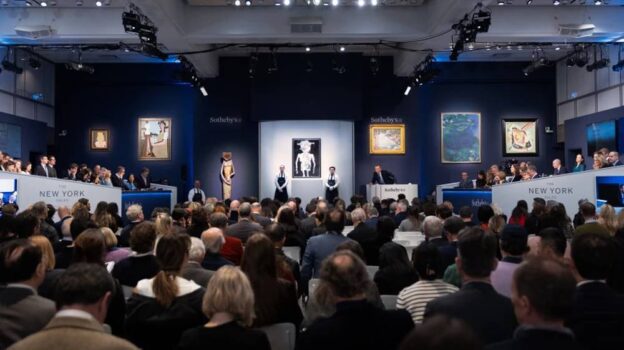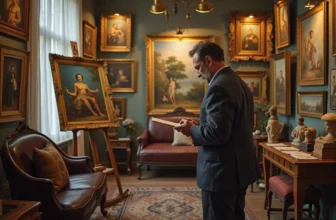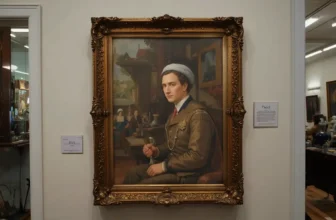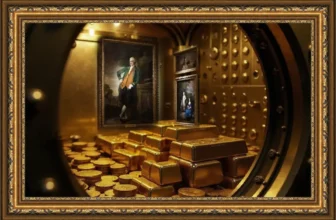Art, Wealth, and Secrecy: The Untold Story of Private Auctions
The Enigma of Private Art Auctions
Shopping Ads: Invest in Hidden Masterpiece: Rare Antique Oil Paintings For Sale. Limited Originals Available 💰😊 Are you looking for authentic hidden masterpiece? Explore old master antique oil paintings from the Renaissance and Baroque eras. From 16th-century portraits to 18th-century landscapes. Authenticity guaranteed, Old Master antique oil paintings for sale. Shop Now! 🎨 Renaissance And Baroque Art Old Master Portrait Paintings Landscape Antique PaintingsThe art market has always been synonymous with glamour, wealth, and exclusivity. While the public usually associates art sales with dazzling galleries or world-famous auction houses like Sotheby’s and Christie’s, another fascinating, lesser-known arena exists: private art auctions. Unlike public auctions, these exclusive events take place behind closed doors, often attended by a select group of invited collectors, dealers, and investors.
Private art auctions are not widely advertised, and the details of what happens inside often remain concealed from the general public. Yet, they play a crucial role in shaping the trajectory of the global art market. From establishing record prices for masterpieces to discreetly handling sales for collectors who value privacy, these hidden transactions reflect both the mystique and power of the art world.
In this article, we’ll take a deep dive into the hidden world of private art auctions, examining how they work, why they exist, who participates, and their broader implications for culture, economics, and investment.
What Are Private Art Auctions?
A private art auction is a sale of artworks conducted outside the public domain. Unlike traditional auctions that are open to anyone willing to bid, private auctions are exclusive events with limited participants. Invitations are typically extended to high-net-worth individuals, museums, foundations, and trusted dealers.
These events differ from public auctions in several ways:
Secrecy: Details of the works sold, the sellers, and even the buyers are often withheld from public records.
Access: Participation is by invitation only.
Customization: Auctions may be tailored to the interests of specific collectors or groups.
Speed and Flexibility: Negotiations and bidding may be handled more quickly compared to lengthy public auction processes.
Private auctions allow for discreet exchanges, shielding both buyer and seller from media attention and public scrutiny. For ultra-wealthy collectors, privacy is often as valuable as the artwork itself.
Why Private Art Auctions Exist
Several factors explain why private art auctions have gained popularity in the 21st century.
1. Privacy and Discretion
For many collectors, anonymity is paramount. High-profile art buyers and sellers, whether celebrities, royalty, or business magnates, often prefer not to have their purchases or sales exposed to the media.
2. Avoiding Market Fluctuations
Public auctions can be unpredictable. A lack of competitive bidding may drive prices down, damaging the perceived value of a piece. Private auctions provide a controlled environment where artworks are more likely to sell at agreed-upon or carefully negotiated prices.
3. Tax and Financial Considerations
Art transactions involve complex tax implications. Private auctions can be structured in ways that benefit both buyers and sellers, such as by leveraging offshore jurisdictions, trusts, or favorable tax laws.
4. Exclusivity as a Status Symbol
For the ultra-wealthy, simply being invited to a private auction enhances their cultural and social prestige. Participation signals belonging to an elite circle of connoisseurs.
5. Relationship Building
Auction houses and private dealers use these events to build long-term relationships with elite collectors, ensuring repeat business and loyalty.
The Inner Mechanics of a Private Art Auction
While the format varies, the process of a private art auction typically unfolds in carefully orchestrated stages.
Selection of Artworks
Artworks are carefully curated, sometimes from estates, private collections, or even museums looking to deaccession pieces discreetly. The works selected often have a high likelihood of selling to the invited clientele.
Curated Invitations
Unlike public auctions, where catalogs are distributed widely, private auctions only extend invitations to a handful of potential buyers. These invitations may include confidential digital or printed catalogs with details about the pieces available.
Bidding Process
The bidding format can differ:
Silent Bidding: Participants submit sealed bids privately.
Closed-Room Bidding: A small group competes in real time, but without an external audience.
Hybrid Models: Some private auctions allow bids through phone or encrypted online platforms.
Negotiation and Flexibility
Unlike the rigid format of public auctions, private sales allow room for negotiation. If the top bid doesn’t meet the seller’s expectations, intermediaries may negotiate directly with bidders to strike a deal.
Finalization and Settlement
Once a deal is reached, payment and transfer of ownership are managed discreetly. Often, specialized escrow services or offshore accounts are used to ensure confidentiality.
Who Attends Private Art Auctions?
High-Net-Worth Collectors
These are individuals whose wealth allows them to acquire blue-chip artworks without financial constraints. For them, art is both an emotional investment and a portfolio diversification tool.
Museums and Institutions
Leading museums sometimes participate in private auctions to secure works for their collections without public competition.
Art Advisors and Consultants
Wealthy clients often rely on art advisors to navigate the intricacies of the market and bid on their behalf.
Wealth Managers and Family Offices
Art is increasingly recognized as an asset class. Wealth managers attend auctions to secure investment-grade pieces for their clients’ portfolios.
Dealers and Galleries
Dealers may purchase artworks privately to later resell them at a premium, leveraging their knowledge of market demand.
Types of Art Typically Sold in Private Auctions
The works sold at private art auctions vary, but certain categories dominate:
Old Masters – Paintings from renowned European artists like Rembrandt, Caravaggio, or Titian.
Modern Art – Works by Picasso, Monet, and Matisse that continue to command record prices.
Contemporary Art – Pieces by artists such as Basquiat, Banksy, or Yayoi Kusama, highly sought after by younger collectors.
Sculpture and Installations – Particularly monumental works that are difficult to trade in open auctions.
Rare Collectibles – From manuscripts and historical artifacts to luxury jewelry and design objects.
Private Auctions vs. Public Auctions
| Feature | Private Auctions | Public Auctions |
|---|---|---|
| Accessibility | Invitation-only | Open to all |
| Transparency | Low (results often undisclosed) | High (results published) |
| Competition | Limited | Open, broad bidding |
| Pricing | Negotiated, discreet | Market-driven |
| Media Exposure | None or minimal | High-profile coverage |
The contrast highlights why many elite collectors prefer private sales: they offer greater control over pricing, privacy, and exposure.
The Role of Auction Houses in Private Sales
Global auction giants like Sotheby’s, Christie’s, and Phillips dominate the private auction market. Over the past two decades, these institutions have expanded their private sales divisions dramatically.
According to industry reports, private sales now account for a significant percentage of overall auction house revenue. Sotheby’s, for instance, has frequently reported billions in private sales annually.
These auction houses leverage their global networks, expertise, and brand trust to facilitate discreet, high-value transactions. They act as intermediaries, ensuring the integrity of the process while keeping the details under wraps.
The Economics of Private Art Auctions
Art as an Asset Class
Art has become more than cultural capital, it’s financial capital. Many collectors view it as a hedge against inflation and a way to diversify their wealth.
Liquidity and Pricing
Private auctions create liquidity in the market for works that might not perform well in public settings. Prices are often negotiated based on private valuations rather than volatile bidding wars.
Confidentiality in High-Value Deals
Transactions exceeding $50 million are often handled privately to protect all parties involved. Confidentiality ensures security and avoids impacting the broader art market.
Controversies Surrounding Private Auctions
While private art auctions offer many benefits, they are not without criticism.
Lack of Transparency
Because prices and sales are often undisclosed, private auctions contribute to the opacity of the art market. This lack of transparency can fuel speculation and manipulation.
Money Laundering Concerns
Regulators have long worried that the secrecy of private auctions makes them a potential vehicle for money laundering. The high values involved, combined with the ease of transferring art across borders, heighten these concerns.
Market Manipulation
By keeping sales private, collectors and dealers can influence perceptions of an artist’s market value. Works may be withheld from public sales to artificially maintain scarcity.
Cultural Heritage Issues
Private auctions sometimes involve the sale of culturally significant artifacts. Critics argue that these pieces should remain accessible to the public rather than disappearing into private collections.
The Rise of Digital and Virtual Private Auctions
The digital revolution has reached even the most exclusive corners of the art world. With the advent of secure online platforms, private auctions can now take place virtually.
Online Privacy and Security
Encrypted bidding systems allow for anonymity, while blockchain technologies are increasingly used to verify provenance and authenticity.
Global Access
Wealthy collectors from around the world can now participate in private auctions without traveling, broadening the potential buyer base.
NFTs and Digital Art
The explosion of non-fungible tokens (NFTs) has opened a new frontier for private sales. High-profile collectors are quietly acquiring digital masterpieces through invitation-only online platforms.
Case Studies: Famous Private Art Sales
Leonardo da Vinci’s “Salvator Mundi”
Although ultimately sold at public auction for $450.3 million, this masterpiece circulated through several private transactions before its headline-making public sale.Picasso’s “Les Femmes d’Alger”
Privately traded multiple times before setting records in the public market.Rothko’s Abstract Masterpieces
Several Rothko works have been sold privately to museums and private collectors, sometimes for sums rivaling public auction records.
These examples show how private auctions often precede or complement public ones, shaping the overall trajectory of the art market.
How to Gain Access to Private Auctions
For collectors hoping to step into this hidden world, access is often the biggest barrier. Some strategies include:
Building Relationships with Auction Houses: Regularly participating in public auctions can lead to invitations to private events.
Working with Art Advisors: Advisors with established networks can secure access for their clients.
Demonstrating Seriousness as a Buyer: Auction houses favor clients with proven purchasing power.
Institutional Connections: Collectors associated with museums or cultural organizations may receive invitations.
The Future of Private Art Auctions
The world of private auctions is evolving rapidly, shaped by technology, regulation, and shifting collector demographics.
Greater Regulatory Scrutiny
Governments are implementing stricter anti-money-laundering (AML) regulations for art transactions. This could reduce some of the secrecy around private sales.
Integration of Blockchain
Blockchain promises to provide transparency and security in verifying ownership and provenance, even in private transactions.
Younger Collectors Entering the Market
Millennial and Gen-Z collectors, often tech-savvy and global, are increasingly participating in private auctions, particularly in the digital and NFT space.
Hybrid Models
We are likely to see more hybrid formats that combine the exclusivity of private auctions with the accessibility of secure online bidding.
The Dual Nature of Private Art Auctions
Private art auctions embody the dual nature of the art market: one side rooted in culture, creativity, and passion, and the other steeped in finance, power, and secrecy. They allow the wealthy to discreetly acquire masterpieces while shaping the trajectory of global art values.
Yet, their hidden nature also raises questions about transparency, cultural responsibility, and the concentration of artistic heritage in private hands.
For collectors, museums, and investors alike, the hidden world of private art auctions will continue to be both alluring and controversial, an essential yet enigmatic part of the global art economy. image/ sothebys




